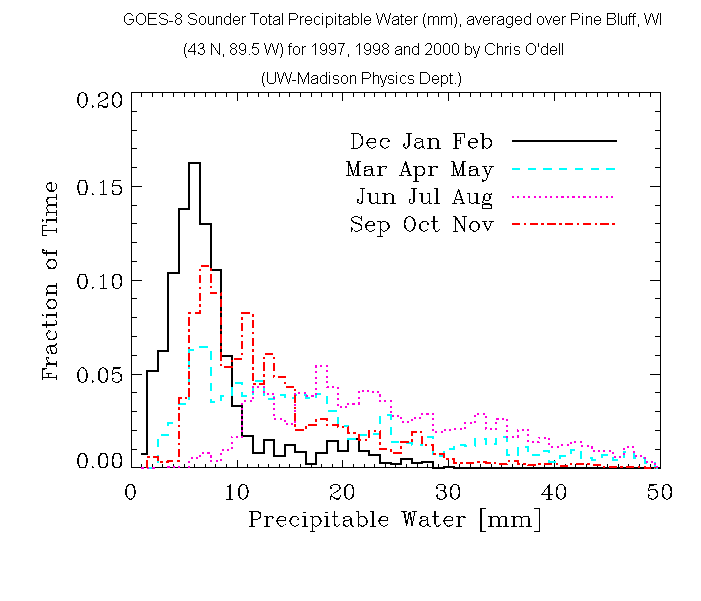
[ Archive ]

 |
CIMSS-NOAA Weekly Report
[ Archive ] |
 |
IN THE PRESS:
ITEMS FOR THE ADMINISTRATOR:
ITEMS FOR THE ASSISTANT ADMINISTRATOR:
ITEMS FOR THE OFFICE DIRECTOR, ORA:
ACCOMPLISHMENTS:
ITEMS FOR THE DIVISION CHIEF, ARAD:
ACCOMPLISHMENTS:
GOES-12 Bias Mode Enabled: On October 11, 2001 the Satellite
Operations Control Center (SOCC) enabled Bias Mode 2 on the Geostationary
Operational Environmental Satellite (GOES) -12 sounder. Infrared
calibration bias factors may vary as the temperature of instrument optical
components vary; between space looks this variation may appear as banding
in the imagery. In Bias Mode 2 the standard algorithm is extended
to minimize the impact of the variations in the bias as a function of optics
temperatures. Both GOES-8 and GOES-10 sounders are operated under
bias mode 2. Researchers at the Cooperative Institute for Meteorological
Satellite Studies (CIMSS) compared sounder bands 12 and 15 before and after
the change and verified that switching to bias mode 2 eliminated banding.
(M. Gunshor, CIMSS, 608-263-1146,
T. Schmit, E/RA2, 608-263-0291)

USWRP Warm Season Precipitation Workshop Planned: R. Aune attended a planning meeting for the Warm Season Precipitation Workshop sponsored by the U.S. Weather Research Program (USWRP) in Boulder, Colorado. The workshop, to be held in March 2002 in a place yet to be determined, will focus on the issues regarding the USWRP goal of improving qualitative precipitation forecasts (QPF) and will lead to a five and ten year research plan. Facilitators were recommended to lead discussion groups for six key subject areas that were identified, including observing system requirements and numerical model limitations. (R. Aune, E/RA2, 608-262-1071)
Overview of Environmental Satellite Fire Monitoring Presented at AMS Satellite Conference: On October 15 E. Prins presented an invited talk at the American Meteorological Society (AMS) 11th Conference on Satellite Meteorology and Oceanography. The title of the presentation was "An Overview of Active Fire Monitoring Using Meteorological Satellites. " The presentation included a summary of current international environmental fire monitoring programs and applications and a glimpse at future remote sensing capabilities. (E. Prins, E/RA2, 608-263-6607, C. Schmidt, CIMSS, 608-262-7973, J. Feltz, CIMSS, 608-263-3434)
Discussions Regarding VIIRS Fire Characterization Capability:
Discussions continued this week with representatives from the National
Environmental Satellite, Data, and Information Service (NESDIS: I. Csiszar,
L. Lauritson, S. Young) and the National Aeronautics and Space Administration
Goddard
Space Flight Center (NASA/GSFC: Giglio) regarding the impact of the
low saturation brightness temperature of the 11 micron band (M15) on the
future VIIRS (Visible and Infrared Imaging Radiometer Suite) for sub-pixel
fire characterization. If the saturation brightness temperature remains
at the proposed 340 K, sub-pixel fire size and temperature estimates will
be limited to only the smallest fires; most fires will saturate the 11
micron band. This will significantly impact the ability to adequately
characterize global biomass burning emissions which are critical for climate
change and emissions modeling. It will also prohibit fire intensity
calculations for most real-time wildfire assessments. (E.
Prins, E/RA2, 608-263-6607)
AMS Conference in Madison: The American Meteological Society's
11th Conference on Satellite Meteorology and Oceanography was held in Madison,
Wisconsin at the Monona Terrace Conference Center, October 15-18.
Posters were presented by R. Aune, G. Wade, E. Prins, T. Schmit, and J.
Key. Colllectively scientists from the Advanced Satellite Products
Team (ASPT) and Cooperative Institute for Meteorological Satellite Studies
presented over 40 posters. Invited presentations were given by E.
Prins (ASPT), S. Ackerman (CIMSS), and H. Revercomb (Space Science and
Engineering Center). (J.
Key, E/RA2, 608-263-2605, C.
Velden, CIMSS, 608-262-9168)
VISITORS:
NEXT WEEK:
LOOKING AHEAD:
IN THE PRESS:
ITEMS FOR THE ADMINISTRATOR:
ITEMS FOR THE ASSISTANT ADMINISTRATOR:
ITEMS FOR THE OFFICE DIRECTOR, ORA:
ITEMS FOR THE DIVISION CHIEF, ARAD:
MUG Meeting Held in Madison: Several Cooperative Institute for Meteorological Satellite Studies (CIMSS) personnel (J. Feltz, D. Stettner, J. Nelson) and T. Schmit (Office of Research and Applications) attended the annual McIDAS (Man computer Interactive Data Access System) Users' Group (MUG) meeting in Madison, Wisconsin on October 19, 2001. Current and future systems and plans were discussed. The McIDAS system continues to evolve. (J. Nelson, CIMSS, 608-263-6013)
GOES-8 Sounder TPW Data Used in Study of Telescope Viewing Times: Geostationary Operational Environmental Satellite (GOES)-8 total precipitable water (TPW) data was provided to a University of Wisconsin-Madison graduate student for use in his Physics (Astronomy) Ph.D. research for determining acceptable telescope viewing times from Pine Bluff, Wisconsin. Chris O'dell seasonally averaged the data over 1997, 1998 and 2000 for the study. (G. Bayler, CIMSS, 608-265-5356)

NEXT WEEK:
LOOKING AHEAD: